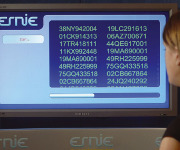Leeds Building Society launches inflation-beating 3% cash ISA

Leeds BS has launched not one but four new accounts. Here's how they shape up.
Leeds Building Society has stormed to the top of the savings tables with two five-year fixed-rate savings accounts paying 3%.
One is a market-leading tax-free Cash ISA and the other a standard savings account.
The ISA is the only savings account on the market to beat the current rate of inflation of 2.8%.
Inflation-busting accounts
The new accounts from Leeds BS are a welcome change to the savings market where rates have been steadily tumbling since the start of the year.
The cash ISA can be opened with £1 and also has the flexibility of allowing in transfers from older Cash ISAs.
For those savers who don’t want to tie their money away for five years, Leeds BS offers a similar ISA with a lower rate of 2.75%. On this ISA, withdrawals of up to 25% of the money invested are allowed without penalty or loss of interest.
The table below shows how these market-leading accounts compare with the current top five Cash ISAs.
|
Account |
Interest rate (AER) |
Minimum deposit |
Length of fixed rate |
Notes |
|
Leeds BS Five-Year Fixed-Rate ISA |
3% |
£1 |
Five years (fixed until 31st October 2018) |
Transfers and new subscriptions. |
|
Leeds BS Five-Year Fixed-Rate ISA (With Access) |
2.75% |
£1 |
Five years (fixed until 31st October 2018) |
Transfers and new subscriptions, up to 25% can be withdrawn |
|
Skipton BS Online Five-Year Fixed-Rate ISA |
2.50% |
£500 |
Five years (fixed until 11th September 2018) |
Transfers and new subscriptions. |
|
United Trust Bank Five-Year Fixed-Rate Cash ISA |
2.45% |
£5,000 |
Five years |
Transfers and new subscriptions. |
|
Coventry BS Three-Year Fixed-Rate ISA |
2.35% |
£5,760 |
Three years (until 31st May 2016) |
New subscriptions only. |
For a comprehensive review of the top ISAs, read The best Cash ISAs.
Fixed-rate savings accounts
Leeds BS also has two new savings accounts on the market which work in the same way, but without the tax benefits.
The first is the Five-Year Fixed-Rate Bond which pays 3% and can be opened with £100. For those who need their money sooner, there’s the option of a 25% access account, which pays 2.75% for the five years.
These can both be opened with £100. The maximum amount allowed is £1,000,000.
Two accounts come close to the Leeds offering, but they both require a higher opening deposit. Shawbrook Bank has a five-year fixed-rate account at the same rate, but you can only open this with £5,000. Secure Trust Bank pays a slightly higher rate of 3.01% but you’ll need at least £1,000 to open it.
Below I’ve listed the top five-year fixed-rate accounts currently on the market.
|
Account |
Term |
Interest rate (AER) |
Minimum deposit |
Access |
|
Secure Trust Bank Fixed-Rate Bond |
Five years |
3.01% |
£1,000 |
Online |
|
Leeds BS Five-Year Fixed-Rate Bond |
Five years |
3% |
£100 |
Online, post, phone, branch |
|
Shawbrook Bank Five-Year Fixed-Rate Bond |
Five years |
3.00% |
£5,000 |
Online, post |
|
Tesco Bank Fixed-Term Bond |
Five years |
2.95% |
£2,000 |
Online, post |
|
ICICI Bank UK HiSAVE Fixed-Rate Account |
Five years |
2.90% |
£1,000 |
Online, phone |
For a full run-down of the best bonds across a range of terms, check out The best fixed-rate savings bond rates
The savings market
The addition of these four accounts is a positive sign for the savings market. For the past year rates have been steadily declining, largely due to the Government’s Funding for Lending Scheme. This has left savers with very few options when looking for places to put their cash.
In July Skipton launched a seven-year savings account paying a market-leading 3.5%. Although the length of the account makes it pretty unappealing, the fact lenders are launching slightly more competitive rates is a positive sign.
Hopefully other providers will follow suit and things will start to change in the savings market.
More on savings:
Why some current accounts are better than savings accounts
The best fixed-rate savings bond rates
The best instant-access savings rates
Is it time to ditch NS&I savings accounts?
Money saving tips for students
Savings rates: British banks versus foreign banks
Most Recent
Comments
-
The self sacrifice of the above posts makes me laugh. All willing to sacrifice their interest for the good of the country. All taking the blame for the bankers greed. All bankers I suspect.It was America and the greed of the American financial institutions that caused the crash. What has happened to the US housing stock and the borrowers that caused the crash. Who is benefitting from that now it must have a value the US banks must be laughing their socks off. We have had several wars since the Falklands, how much did they cost? and are they not the cause of some of our debt. Now the Condems and the US want to drag us into yet another war. Why you may ask, well who is it that is the biggest arms manufacturer, you guessed it the US. As the Tyne shipyard workers said in 1940 it was Hitler that gave them work.
REPORT This comment has been reported. -
It was the windfall from north sea oil that enabled us to pay of the WWII debt, I'm not sure where the windfall is coming from to bail us out of this mess.....
REPORT This comment has been reported. -
Unfirtunately its not just £6000, it £6K this year and the next and the next and so on - although we can hope that the figure would gradually reduce over time. Unfortunately we soon grow accustomed to increased government spending (even when its on borrowed money) and think that it is the new norm. Then we bitch like hell should any of it be whittled away - and we always think spending on oneself is fully justified while spending on others isn't. But New Labour's answer to every thing is to spend more. From 2000 onwards, when world economies were doing well, they continued to borrow more and more when, under the Keynesian economics they now espouse, they should have been paying down debt. I don't blame them for not seeing the crash coming, few did, but it can be almost guaranteed that something would happen to derail the worlds economy, and thats why they are at fault for much of our current problems. The fix would have been so much easier if they hadn't mortgaged us to the hilt. But they did and all sectors of the population benefitted. So I don't agree with those that lay the blame with just the bankers - and that we the general public did nothing to cause the crash, so why should we pay to extracate ourselves from the mess? We all had our snouts in the trough to a greater or lesser degree so we all have to share the pain in getting matters right. It took over 50 years from the end of WWII to get debt to GDP down to reasonable levels, and only a few years to blow much of it all again. And it was that much maligned group the baby boomers who paid off the debt from WWII - and they certainly didn't cause that conflict!
REPORT This comment has been reported.
Do you want to comment on this article? You need to be signed in for this feature









09 September 2013